I think we ended up with a pretty interesting Limited environment. There are many viable draft archetypes, and you can choose to play a multicolor deck or an ordinary 2-color deck.
Jay Treat will be sharing this set in a self-organized prerelease tournament on the Magic Cruise. Most people on the cruise will probably be too busy partying or playing Magic to be reading this, but if you just so happen to be on the cruise, I hope you will try it out!
I'd like to talk about some final questions that arose in the last week of the set.
The final weekend before the deadline was frustrating; the server for the program we had been using for testing was down during most of the weekend. Later on, we experienced scheduling problems between members, but thanks to the help of a reader, Jacob Munford, we were able to get a lot of testing done.
The Effect of Invoker Lands on the Set Mechanic
The few matches that I got in with Jay before the servers went down on Saturday provoked some interesting questions about the land cycle with Invoker-like abilities.
After building some Sealed decks with these lands, Jay and I agreed that they were highly splashable to a point where they were almost auto-inclusions in any deck. However, we had different opinions as to whether that was a good thing or not. For my part, I was delighted that these lands seemed to be creating the exact environment we had been working for but had only been discussing theoretically up till now. Jay, on the other hand, was abhorred by the fact that they were auto-includes even in decks of another color; to him, that felt like robbing the player of choice-making as well as violating the color pie.
As readers of previous posts in this series might know, this set features creatures with abilities similar to Kird Ape like the card to the right, where the creature gains a bonus if you control a certain land type. These creatures are most interesting and dramatic if their bonus turns on in the middle of the game rather than always being on, so we wanted to encourage players to splash a lot of off-color lands in their decks for turning on these Bond bonuses.
At the same time, we didn't want to provide so much mana fixing that decks straddling evenly across 3 colors become optimal; beginners would be locked out of winning if they were required to know how to build a complex mana base.
In my earlier Sealed playtests before the Invoker lands were added, I often had a stray Bond creature that I could run with a few splash lands, but I didn't feel it was worth making my deck more inconsistent, so I often didn't splash the lands. It's a pity since they behave interestingly when they're powered by a splash land. And if I felt it wasn't worth splashing for in Sealed, it would feel even less worth it in Draft.
Adding these Invoker lands to the set seemed to do wonders for that problem. In my first Sealed deck with these lands, I ran every copy that I opened in my pool. The land configuration I ended up with was 7 Forest, 7 Plains, 2 Island, 1 Invoker Swamp, 1 Invoker Mountain, and 1 artifact mana fixer in a 41 card deck. Even though I was playing an almost entirely Green-White deck, it was an easy choice to splash the Invoker Swamp (the card is shown near the top of this post), since it would work as a kind of colorless mana source for my deck with a late game effect attached. The Invoker Mountain worked similarly, except it also gave my Avalanche Wurm (see below) a chance of gaining haste (a 60%+ chance, I believe). The 2 Islands I splashed were for turning on my 4 Windborne Pterons (see below).
These Invoker lands really made you want to play them as a splash, even if it would be the only Swamp or the only Mountain in your deck. This has good impact for Bond. Taking the example with Dark Cove Pirates, if you had a White-Blue deck with a single copy of the Dark Cove Pirates above, you might not want to splash a basic Swamp for it because it would make your mana inconsistent. But an Invoker Swamp would pull its weight as a splash land all by itself, and once it's in your deck, it can make your Pirates behave in an interesting way, turning on its bonus in the middle of the game.
Besides encouraging splashing, they also made the following land destruction spells main-deckable. These spells must be kept clunky so as not to inspire an unfun land destruction strategy. They might not look playable, but they played just fine in testing due to the fact that most decks have good targets for them (the Invoker lands).
Once these land destruction effects are playable and main-deckable, they can occasionally be used to turn off Bond. They make the Bond mechanic's condition a real condition that you can interact with, rather than just being a texty way to write out what a creature's real size is in a particular 2-color deck.
Do Auto-Inclusions Reduce Decisions?
However, one issue that was raised was, is it ok for cards to be auto-includes in any deck? When players are going into a game, they are usually looking to make some choices in the game.
My stance on that was that an auto-include card is only bad if it reduces the total number of choices you make in deck-building. These cards are land cards, and they don't prevent you from making at least the same amount of deck-building choices as usual because you still choose 22 to 23 spells for your creature and spell slots. If these auto-cards were eating up space for other spells in your deck, that might be a problem; there might be another card that you like, but you can't play it because you know this other spell is optimal and has to go in the deck. But that's not the case with these Invoker lands.
Another related issue is, even if it doesn't eliminate choice-making in other parts of the deck, does an auto-include card go against the spirit of Magic, where players choose their spells?
There have been other auto-include cards such as Terramorphic Expanse or Prophetic Prism before, and it's interesting to compare the Invoker lands to them. Is Terramorphic Expanse bad because it's almost always optimal to play every copy you have? I certainly wouldn't describe it as robbing the player of the fun of making choices; even if the choice to run that card is almost automatic, it gives you more choice elsewhere, such as whether to go for a 2-color deck with max consistency or to splash another color. The choice to splash might not have existed if it weren't for the Terramorphic Expanse. The Invoker lands also present you with new choices: choices about whether to play a Bond creature that is turned on by the singleton Invoker land or not.
One possible argument against this though, is that Terramorphic Expanse feels like an innocuous effect in the background, while the Invoker lands feel more like a full-fledged spell effect. To some players, it may feel wrong that the decision to run a type of effect is being made for them almost automatically. It might even feel like being told what to play by the set designer, or by the Sealed pool.
I would be very interested to hear your opinions on this in the comments. Would you feel these Invoker lands are "forcing" you to play them, and feel bad about it?
Are More Decisions Better?
A final issue about automatic choices is: Is it always better to have more choice than less choice? In Limited environments such as Shards of Alara, many of the deck-building choices are entwined with other choices. You have to simultaneously consider the mana fixing for each color combination and the power level of spells in each color combination, and those factors weave a very tangled puzzle. During the time that Alara Reborn was released, the WotC Limited Forums exploded with posts like "how would you build this pool?" reflecting how difficult and intriguing a puzzle it was. While many players including myself enjoyed it, it may have been headache-inducing for beginners.
In this set's case, I actually think it's more enjoyable for players if they didn't have to worry so much about whether they should splash the Invoker lands or not. They could put the Invoker lands in their deck confidently and get that decision out of the way first, and then focus on such decisions as whether they want to play Bond creatures that are turned on by that splash land or not.
There are also some other minor factors that complicate this issue of "auto-inclusion" — namely, the fact that they're not completely automatic choices! The Invoker lands are auto-includes only in Sealed; in Draft, they require players to devote picks on them over other cards.
Also, while they do simplify splashing decisions, sometimes you have another color you want to splash and it would be a legitimate choice to leave the Invoker lands out. For example, in my Sealed deck I talked about above, I could easily have left out either or both of the Invoker Mountain and Invoker Swamp in order to run more Islands to turn on my 4 copies of Windborne Pterons. It was just my preference that I wanted to play with the Invoker lands more; it was a choice for power over consistency.
So they're not completely auto-includes, but I feel that the question of whether it's acceptable for a card with a spell-like effect to be an auto-include card is still a good question to think about in set design.
Do Invoker Lands Break the Color Pie?
Asides from the question of whether a card that's mostly an auto-include card is acceptable or not, another question to consider is whether these cards break the color pie or not. Is it ok if a White-Blue flyers deck aims to muster a swarm of flyers in the early game, then uses an "each creature you control gets +2/+0 until end of turn" effect from the Red Invoker land in the late game to finish the opponent off, without spending Red mana? Or if a White-Black deck uses the Green Invoker land which grants +4/+4 to a creature in order to abuse its lifelink, vigilance, or intimidate creatures?
I feel this is acceptable. First of all, there have been lands with effects that are associated with a color before. Mystifying Maze has an effect reminiscent of White, Quicksand feels Black, Tectonic Edge feels Red, and Thawing Glaciers feels Green. I think this cycle is actually very similar to the Tower cycle in Mirrodin. The Invoker lands don't do anything that an Artifact can't do at a high enough cost, when you consider Equipment or cards like Flying Carpet.
Secondly, these cards actually do have a small cost associated with splashing them — they don't provide colored mana for your main colors if you splash them. With this cost in mind, the fact that a Blue-White flyers deck can have a "creatures you control get +2/+0" in the very late game is a factor for making deck strategies more diverse, rather than more uniform. I've always felt that deck identities can be more diverse if decks were not just defined by the effects they get access to throughout the game, but were defined as a composite of the set of effects they can get in the early game and the set of effects that they get in the late game. In this article, in the section "Facilitate splashing" I wrote some hypothetical examples of Limited archetypes that incorporate a splashed effect:
- A suicidal Black-Red aggro deck that recklessly throws away card advantage for quick damage, then uses card draw spells like Sift to refill.
- A spell-heavy deck in Black-Blue or Red-Blue that controls the board with spells, then uses Spined Wurms and Enormous Baloths to win in the late game.
- A White-Green weenie swarm attack deck that uses a couple of Lava Axe effects to finish the game.
- A Black-Red aggro deck that splashes a White or Green team pump spell or a Blue enchantment that grants mass flying as a finisher.
In response to the fact that these effects can mostly be duplicated with artifacts, an argument was raised that artifacts and lands need to be kept distinct from each other, since they both provide colorless effects and thus cover similar ground. I didn't quite agree with this; cards like Gargoyle Castle or Reliquary Tower feel artifact-like, but they don't make me feel that the two card types will ever become too similar. The difference between lands and artifacts are guaranteed by the fact that lands cost no mana to play, tend to provide mana, and are limited to only one land-drop per turn. Lands are the most distinct card type in the game already.
One legitimate problem that these Invoker lands do have though, is that mana symbols are stamped on them and they decidedly look as if they belong in a particular color. Even if they don't break the color pie in the sense of making all colors play the same way, they might defy player expectation or make them feel something is not right. Magic has a kind of "faction system" for spell effects. It is deeply rooted in Magic players' minds that when you build a deck, you must choose your color associations, and these Invoker lands might feel jarring because they look like they allow you to steal another faction's ability for a very slight cost.
This is another point I would like your opinion on — do these lands look jarring because they allow you to steal an effect of another color?
We considered a version where the Invoker lands look like they require dedication to the color, although it's only a cosmetic change to assuage player psychology:
This one might feel better for players because you actually have to pour Green mana into it, even though it's effectively the same card. (Most of the time since you would tap the card itself to provide the Green mana.)
The Final Style
All of the arguments above are really arguments about how we want to engineer the play environment vs. what would feel natural to players. I wish we had had more time to gather input on what players actually feel is natural.
In the end, we decided to optimize feeling natural to players and go with the following style.
The activation costs were all lined up at 6C, T so that they are easier to keep track of.
Unfortunately, this version will be played less often, because they fit in a smaller percentage of decks. These don't incentivise splashing as much; these would only be splashed if you are prepared to splash more basic lands of the same color to go with it, such as an Invoker Swamp and two basic Swamps. Decks that need higher consistency won't splash them. If a deck is on the verge of splashing that color already, then these lands would definitely provide a tipping point. However, it's different from the earlier case of the Invoker Swamp with a colorless activation cost, where even decks that want consistency can afford to splash it as the only Swamp in the deck, and its presence in the deck can then affect your decision to play Bond cards such as a Dark Cove Pirates.
Although they would be splashed less often, hopefully the Invoker lands will still be played widely enough to make expensive land destruction spells main-deckable.
Aggro vs Control
Another benefit we wanted from these lands is to make the battle between aggro and control more interesting. We didn't want a simple setup of "if aggro overruns the control deck quickly, aggro wins. Otherwise, if the game goes long, control wins with insurmountable card advantage and card power." While we did want control decks to have the advantage in the mid to late game, we also wanted aggro decks to have a chance of making a comeback in the very late game even after the control deck has stabilized.
The Invoker lands seemed to be doing their job for that. They created tension even in a stalled out game. You didn't feel so bad about drawing a basic land after entering top-deck mode, because that brings you one land closer to activating an Invoker land to finish off an opponent. The aggro player still has hope in the late game, and the control player has to try to win in a hurry rather than comfortably stall out the game forever.
It was difficult settling on the right mana cost for activating the lands. Unlike the Invokers from Rise of the Eldrazi, these lands are harder for opponents to destroy, and they are also "free effects" in the sense that they don't require a spell slot, so the cost should be high to reflect that. Then again, our environment isn't as slow as Rise of the Eldrazi. (Although some games actually can go on very long.)
If they are never activated, that's sad. On the other hand, it's also sad when these lands intrude a tense, enjoyable late game and wrap up the game prematurely. With the insufficient testing that we had, we can't be sure that we got it right.
I hope you enjoyed this, and if any readers are interested in playing this set, I hope we can set up a draft some time.

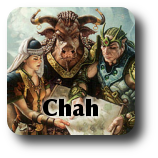
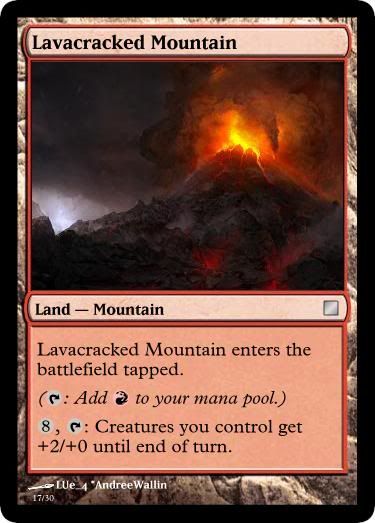
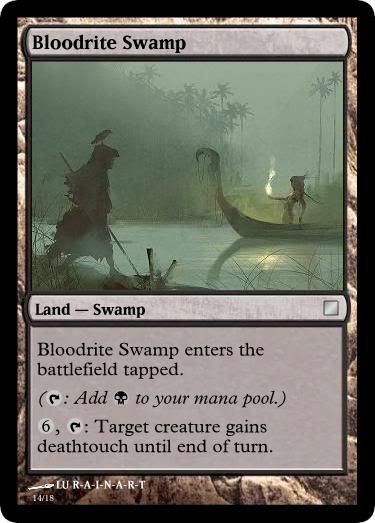
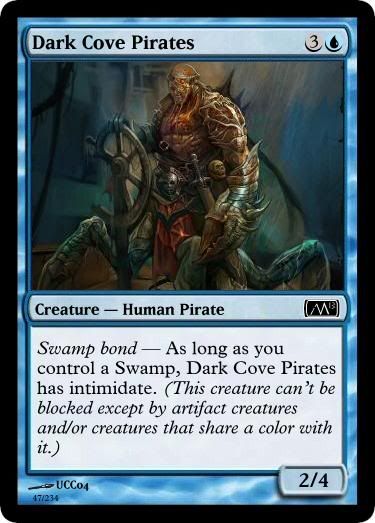
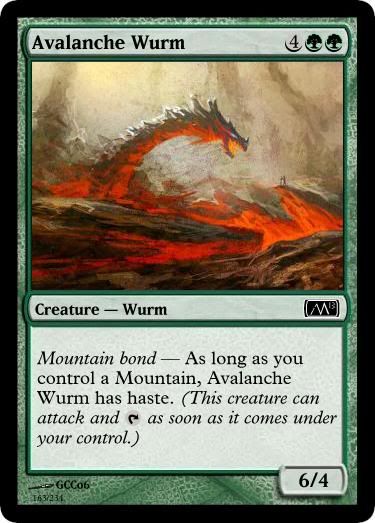

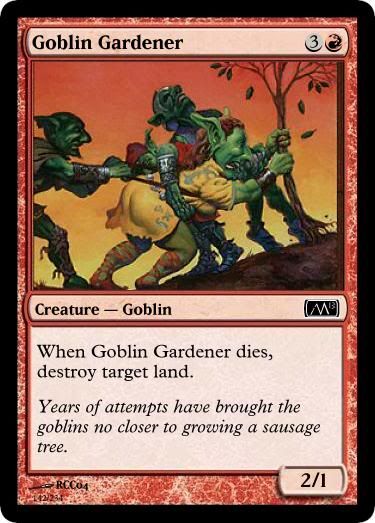

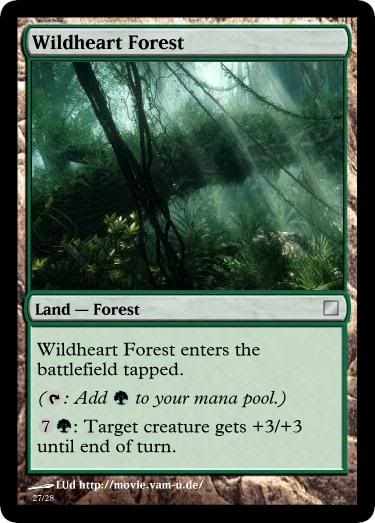
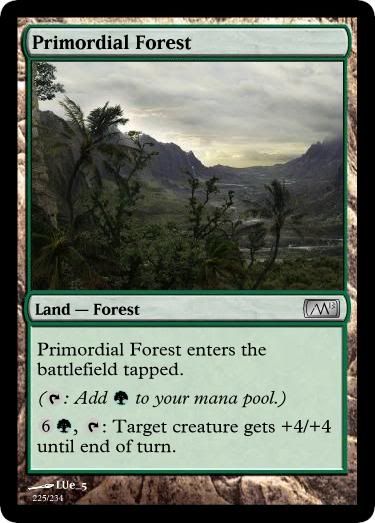
Is a visual spoiler coming?
ReplyDeleteMy thought immediately was that the splashiness of the original invoker lands that required colorless were perfect for the reasons you suggested as it really did allow you to put in your blue swamp bond creature and not feel like you should put in a swamp to make it better, but don't want to because it'll kill your mana base; in fact, the splashy invokers helped reduce the additional mana screw bond creates as if you put one or two swamps in your deck, they suck unless you get them at the exact right time.
ReplyDeleteThe problem with the invoker-lands was that they are so universal, they go in anything even if you've not got anything to bond. To me, the solution is simple: keep their splashable costs but give them very specific, linear effects. That way, people will splash them if they help their deck's strategy and with bond, but if they don't have a way of using the strategy, they won't bother.
For example; the white land could tutor up and play an aura for free, the blue land could give a boost to pirates, the black land could make your opponent's creatures colorless, the red land could damage a player if they've been damaged this turn, and the green land could give you life based on a creature's toughness.
I can imagine that you would see an invoker land with a colorless activation cost with a subtype and not pick it because the invoker ability just doesn't play into your strategy at all.
I like the invoke lands a lot, and I think you guys ended up with an ideal cost. When I think of a core set "splash," I usually think 2 lands in the splash color -- so it seems reasonable that I would play an invoke land, and then a basic of that type.
ReplyDelete"There haven't been many Limited archetypes that take the splashing of a late-game effect into account, but that doesn't mean there can't be one in the future."
Is that true? Splashing red to add a Fireball to your GW fatty deck with ramp and elves seems like a classic deckbuilding move to me.